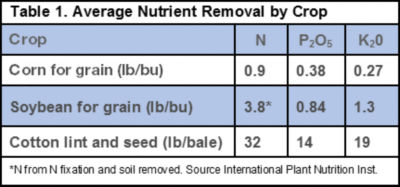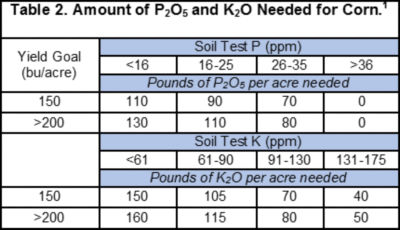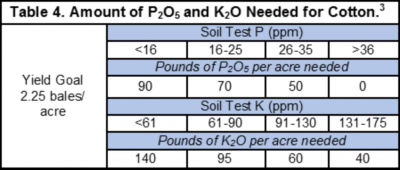Corn, Soybean and Cotton Fertility
October 4, 2018
Soil testing is the most useful means of determining what inventories of nutrients are available for crop production. In a period of rising fertilizer prices, soil testing allows a grower to prioritize fertilizer applications, and focus on inputs that will provide the greatest return in crop production.
Soil tests are recommended at least every four years. Nutrient availability is highly influenced by soil and/or environmental conditions, and as such, understanding the correct amount of nutrients to apply is critical to help maximize returns. Whole field, grid, and management zone sampling are three tactics that can be used. Consult with your nutrient provider or crop consultant on which tactic will provide the best results for your farming operation.
Lime
Maintaining the pH needed by each crop is important for efficient uptake and utilization of plant nutrients. For corn the target range is 5.8 to 7, for soybeans it is 6.5 to 7, and for cotton it is 5.8 to 8. Liming materials are classified by the Relative Neutralizing Values (RNV). The RNV of a material is based on its fineness and Calcium Carbonate Equivalent (CCE or the amount of pure calcium carbonate to which the selected material corresponds), with finer materials reacting more quickly than coarse materials. An Ag lime material with a CCE of 100 is “stronger” than an Ag lime material with a CCE of 80; consequently, less volume would be needed to increase the pH of a given soil.
Fertility Recommendations
Specific suggestions for cotton, corn, and soybeans can be found in our agronomic library at http://www.aganytime.com For cotton, type in Cotton Fertility in the search box, for corn, type in Corn Fertility in Medium– to High-Yield Environments in the search box, and for soybeans type in Soybean Fertility in Medium- to High-Yield Environments in the search box.

Nitrogen (N) rates for corn should be based on expected yield goal and soil type will dictate N application rates. Usually, clay and silt-clay soils will require slightly more N than sandy loam and silt loam soils. Split applications are usually more efficient, with approximately 1/4 of the N applied pre-plant or at planting, and the remainder applied between V4 to V6, and between V12 to V14. For example, for a 175 bushel yield goal for sandy and silt loams apply 220 lb/acre of total N and for clay soils apply 290 lb/acre of total N. In cotton, split applications are also recommended with applications after plant establishment and at early squaring. Recommended rates range from 80 to 120 lb/acre of total N.
For Phosphorus (P) and Potassium (K) recommendations, consult Table 2 through 4.



Micronutrients
Sulfur is a key micronutrient for corn that can be lacking. For corn and cotton, if S soil test is <10 parts per million, consider an application of 20 to 25 lb/acre of S.1,3 In corn, if Zinc levels are <4 parts per million and soil pH is >6, consider at least applying 10 lb/acre of Zinc.1
Sources:
1Kelly, J. and Lawson, K. 2017 Arkansas Corn Quick Facts. University of Arkansas. Extension. https://www.uaex.edu.
2Ross, J., Elkins, C, and Norton, C. 2017 Arkansas Soybean Quick Facts. University of Arkansas. Extension. https://www.uaex.edu
3Robertson, B, Barber, T., and Lorenz, G. M2017 Arkansas Cotton Quick Facts. University of Arkansas. Extension. https://www.uaex.edu
Web sources verified 10/1/2018. 181013125234 10052018MW